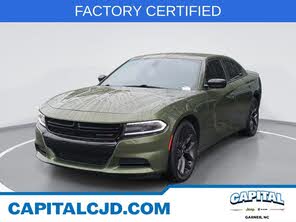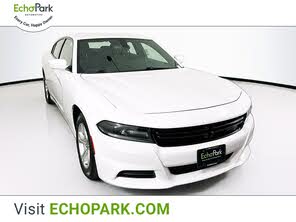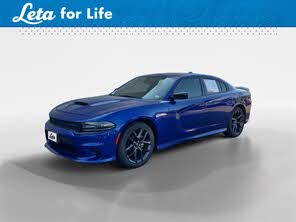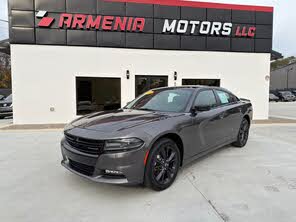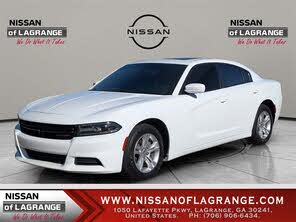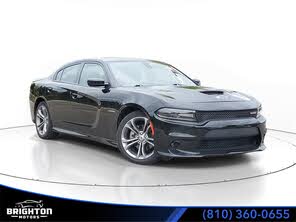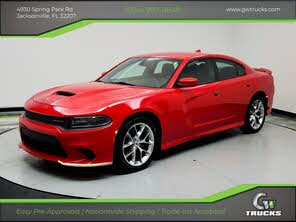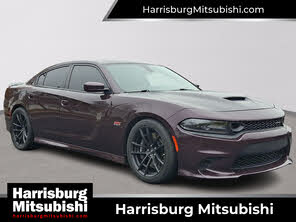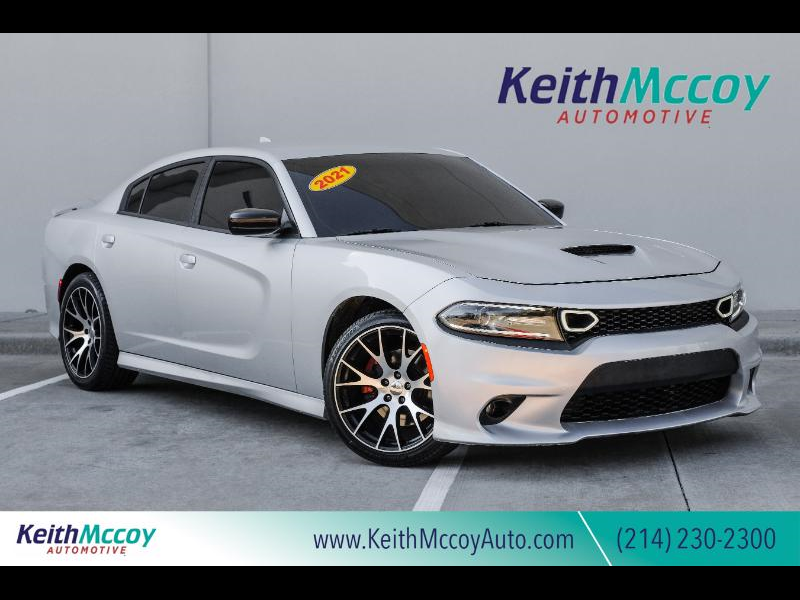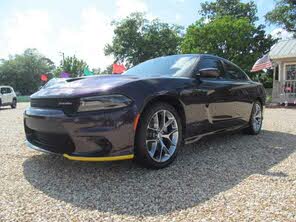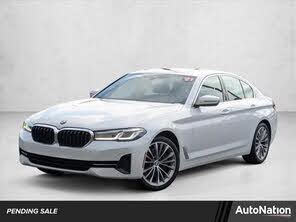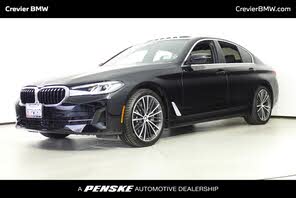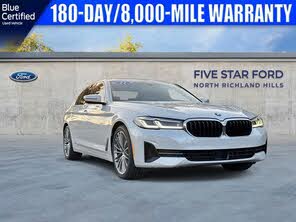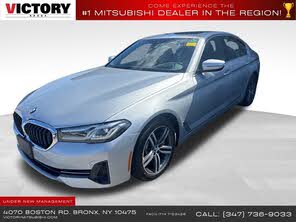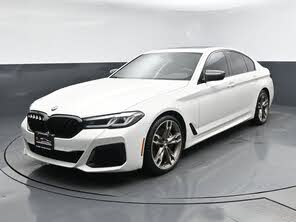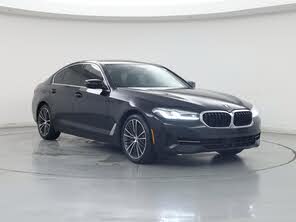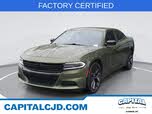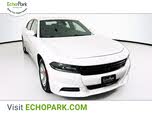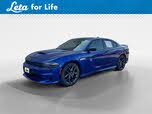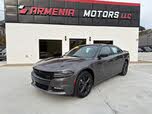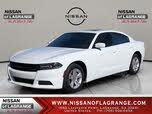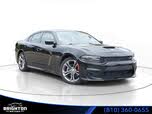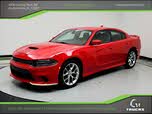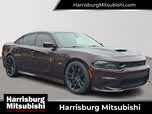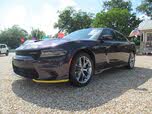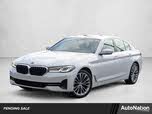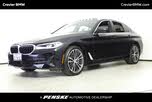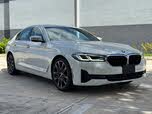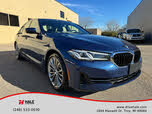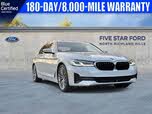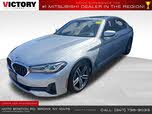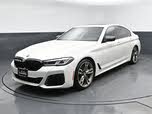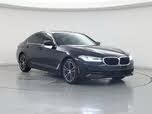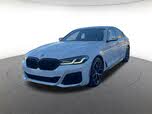2021 Dodge Charger vs 2021 BMW 5 Series
Overview | |
MSRP$54,200 | MSRP$31,125 |
Listings295 | Listings1092 |
Ratings & Reviews | |
User Reviews | User Reviews |
Expert reviews8.0 out of 10 | Expert reviews7.8 out of 10 |
Pros
Cons
| Pros
Cons
|
2021 BMW 5 Series Reviews SummaryBMW was once known for sports sedans, and the 5 Series was one of the most prolific of those sedans. Sitting between the 3 Series and 7 Series in size and price, previous generations of 5 Series were known for a balance of performance and luxury, with impeccable engineering throughout. Today, the BMW 5 Series is largely irrelevant. The 3 Series is now so big that there is less reason to upgrade, and most buyers are more interested in SUVs anyway. The competition—including the Audi A6, Jaguar XF, Mercedes-Benz E-Class, and Volvo S90—has also gotten better. That doesn’t mean BMW has given up on the 5 Series. The current generation (codename G30) arrived for the 2017 model year, but it gets a midcycle refresh (or LCI, short for “Life Cycle Impulse,” in BMW speak) for 2021. Major updates include a 48-volt mild-hybrid system, a bigger infotainment touchscreen, and subtle styling changes. The 2021 BMW 5 Series is not like the 5 Series models of old. That may drive away hardcore car fans, but the 2021 model makes a strong case to new-car buyers, maintaining sportier-than-average driving dynamics, along with the tech and luxury features expected of a car in this segment. | |
2021 Dodge Charger Reviews SummaryWhen it comes to American muscle cars, few do it better than the Dodge Charger. It’s a unique breed—new four-door muscle cars just aren’t sold in the United States. anymore. There is a new track-ready variant for the 2021 model year that pushes the limits of the car’s Hellcat V8 engine. Tamer versions of the car offer less horsepower but can still fit three car seats across the back of the car’s roomy cabin and have accommodations comfortable enough to make it a daily driver. | |
No video found | No video found |
Popular Features & Specs | |
Engine2.0L 248 hp I4 | Engine3.6L 292 hp V6 |
Drive TrainRWD | Drive TrainRWD |
Seating Capacity5 | Seating Capacity5 |
Horsepower248 hp @ 5200 rpm | Horsepower292 hp @ 6350 rpm |
MPG City25 | MPG City19 |
MPG Highway33 | MPG Highway30 |
Engine | |
Engine Name2.0L 248 hp I4 | Engine Name3.6L 292 hp V6 |
Torque257 lb-ft @ 1500 rpm | Torque260 lb-ft @ 4800 rpm |
Horsepower248 hp @ 5200 rpm | Horsepower292 hp @ 6350 rpm |
DrivetrainRWD | DrivetrainRWD |
Fuel Economy | |
MPG City25 | MPG City19 |
MPG Highway33 | MPG Highway30 |
Interior | |
Seating Capacity5 | Seating Capacity5 |
Key Features | |
Navigation SystemStandard | Navigation System |
Sunroof/MoonroofStandard | Sunroof/Moonroof |
Safety | |
Front Crash Overall | Front Crash Overall4 |
Side Crash Overall | Side Crash Overall5 |
Dimensions & Capacity | |
Cargo Space14.0 cu ft | Cargo Space16.5 cu ft |
Curb Weight3765 lbs | Curb Weight3957 lbs |
Height58.2 in | Height57.8 in |
Length195.8 in | Length198.4 in |
Width83.7 in | Width82.7 in |
Wheelbase117.1 in | Wheelbase120.0 in |
Maximum Payload800 lbs | Maximum Payload1143 lbs |
Number of doors4 | Number of doors4 |
Maximum Towing Capacity | Maximum Towing Capacity1000 lbs |
Overview | ||
MSRP | $54,200 | $31,125 |
Listings | ||
Ratings & Reviews | ||
User reviews | ||
Expert reviews | 8.0 out of 10Read full review | 7.8 out of 10Read full review |
Pros & cons | Pros
Cons
| Pros
Cons
|
Summary | BMW was once known for sports sedans, and the 5 Series was one of the most prolific of those sedans. Sitting between the 3 Series and 7 Series in size and price, previous generations of 5 Series were known for a balance of performance and luxury, with impeccable engineering throughout. Today, the BMW 5 Series is largely irrelevant. The 3 Series is now so big that there is less reason to upgrade, and most buyers are more interested in SUVs anyway. The competition—including the Audi A6, Jaguar XF, Mercedes-Benz E-Class, and Volvo S90—has also gotten better. That doesn’t mean BMW has given up on the 5 Series. The current generation (codename G30) arrived for the 2017 model year, but it gets a midcycle refresh (or LCI, short for “Life Cycle Impulse,” in BMW speak) for 2021. Major updates include a 48-volt mild-hybrid system, a bigger infotainment touchscreen, and subtle styling changes. The 2021 BMW 5 Series is not like the 5 Series models of old. That may drive away hardcore car fans, but the 2021 model makes a strong case to new-car buyers, maintaining sportier-than-average driving dynamics, along with the tech and luxury features expected of a car in this segment. | When it comes to American muscle cars, few do it better than the Dodge Charger. It’s a unique breed—new four-door muscle cars just aren’t sold in the United States. anymore. There is a new track-ready variant for the 2021 model year that pushes the limits of the car’s Hellcat V8 engine. Tamer versions of the car offer less horsepower but can still fit three car seats across the back of the car’s roomy cabin and have accommodations comfortable enough to make it a daily driver. |
Video | No video found | No video found |
Popular Features & Specs | ||
Engine | 2.0L 248 hp I4 | 3.6L 292 hp V6 |
Drive Train | RWD | RWD |
Seating Capacity | 5 | 5 |
Horsepower | 248 hp @ 5200 rpm | 292 hp @ 6350 rpm |
MPG City | 25 | 19 |
MPG Highway | 33 | 30 |
Engine | ||
Engine Name | 2.0L 248 hp I4 | 3.6L 292 hp V6 |
Torque | 257 lb-ft @ 1500 rpm | 260 lb-ft @ 4800 rpm |
Horsepower | 248 hp @ 5200 rpm | 292 hp @ 6350 rpm |
Drivetrain | RWD | RWD |
Fuel Economy | ||
MPG City | 25 | 19 |
MPG Highway | 33 | 30 |
Interior | ||
Seating Capacity | 5 | 5 |
Key Features | ||
Navigation System | Standard | |
Sunroof/Moonroof | Standard | |
Safety | ||
Front Crash Overall | 4 | |
Side Crash Overall | 5 | |
Dimensions & Capacity | ||
Cargo Space | 14.0 cu ft | 16.5 cu ft |
Curb Weight | 3765 lbs | 3957 lbs |
Height | 58.2 in | 57.8 in |
Length | 195.8 in | 198.4 in |
Width | 83.7 in | 82.7 in |
Wheelbase | 117.1 in | 120.0 in |
Maximum Payload | 800 lbs | 1143 lbs |
Number of doors | 4 | 4 |
Maximum Towing Capacity | 1000 lbs | |
The 2021 BMW 5 Series boasted a restrained design, positioning itself as the most understated BMW sedan of its time. Unlike the 3 Series' design quirks or the 7 Series' imposing size, the 5 Series flew under the radar. The 2021 model's minor styling refresh imbued the sedan with a sleeker look, featuring streamlined LED headlights and a tweaked twin-kidney grille. The grille, while larger than before, avoided the comically large dimensions seen on the 7 Series.
Updated trapezoidal tailpipes, L-shaped taillights, and refreshed front and rear bumpers distinguished the M Sport Package. The car grew by 1.2 inches but maintained an aerodynamic drag coefficient of 0.27, improving efficiency. Inside, the 5 Series retained its familiar BMW layout. Elements like the touchscreen positioning, the unconventional shifter design, and the specific typefaces and door chimes emphasized BMW's unique style. Despite the prestigious badge, entry-level trims featured standard SensaTec upholstery instead of genuine leather, with premium Dakota and Nappa leathers available for extra costs. Our 540i xDrive test car, with Nappa leather in Mocha, exuded luxury. Aluminum trim with a unique scale pattern added to the upscale feel, though the sporty steering wheel felt out of place given the minimal effort required by the electric power steering.
Meanwhile, the 2021 Dodge Charger had been a staple in Dodge's lineup for a decade. Available in a wide array of variants, the Charger remained extremely popular. Trims ranged from the base SXT to the top-tier SRT Hellcat Redeye. Though the surface differentiation between models was subtle, intentional design choices catered to the "brotherhood of muscle" ethos that Dodge fostered.
The Charger offered both regular and widebody formats, the latter adding an athletic stance to the vehicle. Fresh for 2021, the Dodge Charger SRT Hellcat Redeye featured a performance hood options in Satin Black, further enhancing its aggressive stance. Buyers could select tire, wheel, brake, and exterior color options to suit their preferences. Wheel sizes ranged from 17 to 20 inches, and up to 18 wheel options were available across trims. Thirteen paint jobs with names like Hellraisin and Triple Nickel added a fun element to the selections.
Halogen projector headlights with LED accents were standard, while HID projector lights and fog lamps were optional. Despite minor updates over the years, the Charger's overall design remained consistent, making it difficult for casual observers to gauge the car's age—a double-edged sword for the vehicle's aesthetic.
The interior of the Charger had aged, and it retained a fair amount of hard plastic and rubberized surfaces. While not quite as plush as Dodge's Ram 1500, it featured utilitarian design elements more reminiscent of a Jeep Wrangler. Cloth seats were standard on most models, with Nappa leather on higher trims. Driver and passenger seat configurations varied, with some offering heated and ventilated options.















BMW offered the 2021 5 Series with a variety of powertrains. The base 530i came with a 2.0-liter turbocharged four-cylinder engine producing 248 horsepower and 258 pound-feet of torque, achieving 0 to 60 mph in 5.9 seconds. The top speed was limited to 130 mph with standard tires, and 155 mph with performance tires. An eight-speed automatic transmission was standard, with xDrive all-wheel drive as an option.
The 540i upgrade featured a 3.0-liter turbocharged inline-six engine paired with a 48-volt mild hybrid system. Though not fully electric, this setup improved start-stop efficiency and powered small accessories. The 540i offered 335 hp and 362 lb-ft of torque, with rear-wheel drive accelerating from 0 to 60 mph in 4.9 seconds and xDrive in 4.6 seconds.
For those desiring more power, BMW provided the M550i xDrive with a 4.4-liter twin-turbo V8 generating 532 hp and 553 lb-ft of torque, reducing the 0 to 60 mph time by a second compared to the 540i xDrive. The pinnacle was the M5 with a 617 hp V8, zooming from 0 to 60 mph in just 3.1 seconds and reaching 190 mph with the optional M Driver’s Package.
The 530e plug-in hybrid combined a 2.0-liter engine with an electric motor for 288 hp and 310 lb-ft of torque, managing 0 to 60 mph in 5.7 seconds and capable of purely electric driving for moderate distances.
Conversely, the 2021 Dodge Charger sported a range of engines. The SXT and GT models, including their AWD variants, utilized a 3.6-liter V6 with 300 hp and 264 lb-ft of torque. Offering respectable fuel economy, this engine was suitable for daily drivers prioritizing efficiency.
The Charger R/T ramped up with a 5.7-liter HEMI V8 delivering 370 hp and 395 lb-ft of torque, and with a 1,000-pound towing capacity. The Charger Scat Pack featured a 6.4-liter HEMI V8 engine offering 485 hp and 475 lb-ft of torque.
For the high-performance models, the SRT Hellcat packed a supercharged 6.2-liter HEMI V8 producing 717 hp and 650 lb-ft of torque. Topping the range, the SRT Hellcat Redeye had the same engine tuned for 797 hp and 707 lb-ft of torque, managed through a high-performance eight-speed automatic transmission. Despite its power, the Redeye offered a surprisingly manageable and adaptable driving experience.
The top-of-the-line powertrain was predictably thirsty, with an EPA rating of 12 mpg city, 21 mpg highway, and 15 mpg combined. Configurable drive modes were standard in higher trims, with SRT models featuring a Performance Pages function in the infotainment system.
The 2021 BMW 5 Series, available as a four-door, five-seat sedan, no longer came in a wagon variant in the U.S. Its rivals, like the Mercedes-Benz E-Class and Audi A6, still offered such versatility. With generous proportions, the 5 Series sedan provided ample space. Front-seat room was competitive, while rear seats, despite appearing less roomy on paper compared to competitors, still offered substantial comfort. With 14.0 cubic feet of trunk space, the 540i outmatched the Audi A6 and Mercedes-Benz E-Class. The rear bench featured a 40/20/20 split fold, allowing for longer items to fit easily.
The test car’s 16-way power front seats provided excellent support, with features like four-way lumbar support, driver memory, heating, and ventilation. Visibility over the high hood was a challenge, but the surround-view camera system mitigated parking difficulties.
The 2021 Dodge Charger conveniently doubled as a family car with its spacious interior. The instrument cluster varied by model, with speedometer ranges reflecting each model's capabilities, up to 220 mph in the highest trims. While straightforward to use, the tech felt dated.
The steering wheel, equipped with essential function buttons and paddle shifters (except in the base model), was practical but sometimes cumbersome during sharp maneuvers. A 60/40 split-folding rear seat expanded the already spacious trunk, making the Charger comparable to other large cars in cargo capacity.
The BMW 5 Series had a slight edge in trunk space with its 14 cubic feet compared to the Charger's sizable cargo area, though the Charger remained competitive with its roomy back seat and expandable trunk functionality.
For 2021, the BMW 5 Series upgraded its infotainment to a standard 12.3-inch touchscreen featuring the latest iDrive 7 system. Accompanying this was a 12.3-inch Live Cockpit Professional digital instrument cluster. Standard features included Apple CarPlay/Android Auto, Bluetooth, SiriusXM 360L satellite radio, and a built-in WiFi hotspot.
The graphics quality was top-notch, though the instrument cluster layout could be improved. A power meter replaced the tachometer in all modes except sport, a change likely to confuse some drivers. Essential infotainment functions could be controlled via a tactile rotary knob, offering a better experience than touchscreen-only interfaces. Voice control, prompted by “Hey BMW,” and gesture controls for functions like volume adjustment were available, though gesture precision could improve.
Conversely, the 2021 Dodge Charger’s base model came with a 7-inch touchscreen that sufficed but didn’t excel. Standard features included push-button start, a rearview camera, rear parking sensors, a six-speaker audio system, multiple USB ports, Bluetooth, Apple CarPlay, and Android Auto.
Available upgrades included an 8.4-inch touchscreen, dual-zone automatic climate control, premium audio systems (up to a 19-speaker Harman Kardon setup), HD Radio, navigation, and a WiFi hotspot. However, a lack of more advanced technologies like a head-up display detracted from the tech appeal. While Uconnect, Dodge’s infotainment system, was relatively user-friendly, it sometimes buried essential functions too deep in menus, and the latest Uconnect version had yet to debut on the Charger.
The Insurance Institute for Highway Safety (IIHS) hadn’t crash-tested the 2021 BMW 5 Series, but the structurally similar 2020 model received a “Top Safety Pick+” award, indicating high safety ratings in all crash tests and front-crash prevention. The standard headlights received a “marginal” rating, while optional lights were rated “good.”
The 2021 5 Series came with standard features like lane-departure warning, automatic emergency braking, blind-spot monitoring with rear cross-traffic alert, and automatic high beams. The available Driving Assistance Plus Package added adaptive cruise control, traffic-jam assist, lane-keep assist, and emergency stop assist. These advanced driver-assist features operated smoothly, often mimicking the inputs of a competent human driver even in complex traffic situations.
The 2021 Dodge Charger hadn’t been crash-tested by IIHS, but the 2020 model received mostly “Good” ratings in crashworthiness and “Poor” for headlights. The National Highway Traffic Safety Administration (NHTSA) awarded the Charger a four-star overall safety rating for 2021.
Standard safety features included brake assist, electronic stability control, hill start assist, rear park assist, rain brake support, and a tire pressure monitoring system. Higher trims offered adaptive cruise control, blind-spot monitoring, forward-collision warning, lane-departure warning, and automatic headlights, although these were not always standard.
CarGurus highlights

According to CarGurus experts, the overall rating for the 2021 BMW 5 Series is 8.0 out of 10, while the 2021 Dodge Charger scores 7.8 out of 10. Based on these ratings, the BMW 5 Series emerges as the better-rounded choice, offering a refined balance of performance, luxury, technology, and safety.
Choose the 2021 Dodge Charger if:
- You crave a powerful performance, especially in the top-tier SRT Hellcat and Hellcat Redeye variants.
- A versatile model range with multiple engine options from V6 to high-output V8 appeals to you.
- You need a spacious sedan that can double as a family car without sacrificing sporty attributes.
Choose the 2021 BMW 5 Series if:
- You prioritize a sophisticated hybrid system paired with a variety of powerful engines.
- Advanced driver-assist features and top-tier safety ratings are essential.
- High-quality interior materials and a modern, intuitive infotainment system are what you're after.
CarGurus highlights

According to CarGurus experts, the overall rating for the 2021 BMW 5 Series is 8.0 out of 10, while the 2021 Dodge Charger scores 7.8 out of 10. Based on these ratings, the BMW 5 Series emerges as the better-rounded choice, offering a refined balance of performance, luxury, technology, and safety.
Choose the 2021 Dodge Charger if:
Shop Now- You crave a powerful performance, especially in the top-tier SRT Hellcat and Hellcat Redeye variants.
- A versatile model range with multiple engine options from V6 to high-output V8 appeals to you.
- You need a spacious sedan that can double as a family car without sacrificing sporty attributes.
Choose the 2021 BMW 5 Series if:
Shop Now- You prioritize a sophisticated hybrid system paired with a variety of powerful engines.
- Advanced driver-assist features and top-tier safety ratings are essential.
- High-quality interior materials and a modern, intuitive infotainment system are what you're after.

By: CarGurus + AI
At CarGurus, our team of experienced automotive writers remain at the heart of our content operation, conducting hands-on car tests and writing insightful guides that are backed by years of industry experience. To complement this, we are harnessing AI to make our content offering more diverse and more helpful to shoppers than ever. To achieve this, our AI systems are based exclusively on CarGurus content, ratings and data, so that what we produce is both unique to CarGurus, and uniquely helpful to car shoppers.

